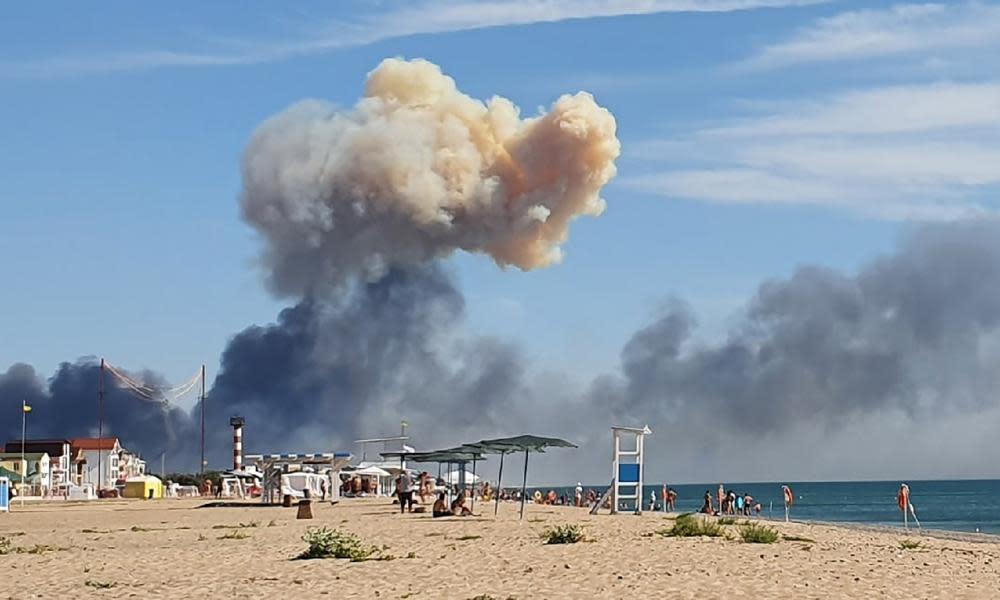Ukrainian attack on Russian airbase sends message to Moscow and beyond

The satellite images from the Saky airbase in occupied Crimea do not lie. Nine Russian fighter jets were estimated to have been destroyed – though the true figure could be greater – some marked by little more than blackened streaks on the ground after a series of fierce explosions on Tuesday afternoon.
It amounts to perhaps a fifth of all recorded Russian combat aircraft losses in the war in Ukraine, now 47 as counted by analysts at Oryx, and while Moscow’s air force has dozens more fighters in its arsenal, the scale of the success and its immediate propaganda value cannot be overestimated.
Although not the first Ukrainian attack in Crimea since the start of the war, it is the most significant, not just because it took place 110 miles (177km) or so behind the frontline but because it took place in the sight of thousands of tourists. Videos showed sunbathing Russians hastily leaving their sun loungers with the clouds from the explosion in the distance, and later apparently clogging up roads out of the peninsula with traffic.
Ukrainian propagandists wasted little time to reinforce the point: the country’s defence ministry released a video aimed at ordinary Russian holidaymakers. Accompanied by the strain of Bananarama’s Cruel Summer, it suggested “you had a few options” for a summer vacation but warned “you chose Crimea – big mistake”, followed by footage of the explosions as seen from the beach.
Russia’s public may have a different perception of the war in Ukraine, but occasionally news of setbacks filters through. The destruction of warplanes at Saky will rank with disasters such as the sinking of the cruiser Moskva in April or the estimated loss of more than 70 armoured vehicles in the failed river crossing at Bilohorivka in Donbas in March. Word of mouth from those fleeing will amplify the impact.
But losses are a fact of war, so a further question is: what military and political impact will the attack have? Ukraine has been notably reluctant to formally claim responsibility in public, though officials are doing so in private. That suggests Kyiv wants to preserve some ambiguity about how the attack took place, not least because it will hope to repeat the success again.
Certainly, the attackers knew what they were aiming for, likely striking more than one ammunition or fuel dump, sited unwisely near the aircraft, leading to the intense explosions and fire whose impact can be seen not just from the satellite imagery but from a video of a string of burnt out cars parked nearby. Such precision can only be achieved with accurate local intelligence, a troubling point for the Russians.
The most likely scenario is that the dumps were struck from relatively short range, possibly with a kamikaze drone, in a daring raid by special forces or partisans. The use of long-range missiles has not been ruled out, as the airbase is theoretically in reach of Neptune missiles fired from Odesa, 165 miles away, but those studying the explosion videos have found little evidence to support this.
Justin Bronk, an analyst at the Royal United Services Institute defence and security thinktank, said the primary military significance of the attack was not in terms of the numbers of aircraft destroyed but rather the impact it would have on the Russian air force’s sense of security. The air force, he said, “will have less confidence in their force protection capabilities within several hundred kilometres of the frontlines”.
This could mean Russian forces would have to “devote more troops, equipment and effort to protecting their airbases”, Bronk added, drawing away forces from the frontline, “or rely on airbases that are significantly further away” with knock-on impacts on efficiency and effectiveness.
Ukraine’s short-term goal, however, is much larger – to try to mount a broad counter-offensive before the autumn to force Russian troops out of Kherson, the one city west of the Dnieper River the invaders hold.
Related: Russian warplanes destroyed in Crimea airbase attack, satellite images show
What Ukraine’s forces are doing – and this too would partly explain the operational secrecy – is staging a string of attacks aimed at military bases and ammunition dumps, presumably to disrupt Russian logistics and degrade Moscow’s ability to defend and reinforce Kherson.
Attacks have mostly taken place around the city and in the wider Kherson province, including on Tuesday, reports suggest, at a depot in Novooleksiivka, a road and rail link to Crimea – although the Sevastopol naval base in southern Crimea was struck in what the Russians said was a drone strike at the end of July.
The question becomes whether such attacks will seriously weaken Russia’s ability to resist a full counterattack, or simply amount to social media propaganda coups. That will only be tested if Ukraine is able to amass enough combat power to try to advance on the city.
Meanwhile, there is the obvious concern that Russia, stung by the attack on what it thought was its back yard, will seek to retaliate.

 Yahoo News
Yahoo News 
